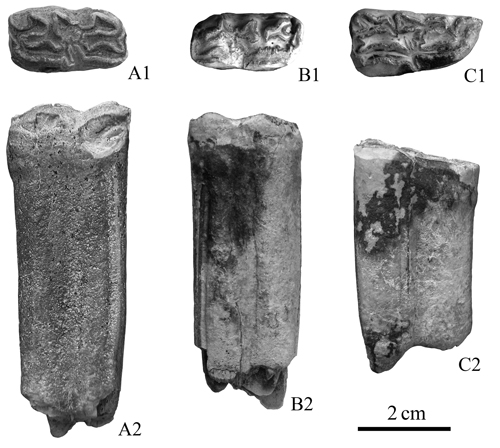| Location: Home > Research > Research Progress |
| Two Rare Hipparion Species Found from Pliocene Deposits of Inner Mongolia |
|
PANG Li-Bo, a graduate student paleontologist from Institute of Vertebrate Paleontology and Paleoanthropology, Chinese Academy of Sciences, identified two rare species of Hipparion- Hipparion (Baryhipparion) insperatum and Hipparion (Plesiohipparion) huangheense, from Pliocene sediments at the Gaotege locality, Inner Mongolia, as reported in the latest issue of Vertebrata PalAsiatic 2011(2), indicating they are much widely distributed than thought before and providing new materials for studies on paleobiogeography. The Gaotege locality is about 70 km southwest of Xilinhot and 33 km northeast of Tsagan Nor in Abag Qi (Banner) of central Inner Mongolia. Hipparion (Greek, "pony") resembled the modern horse. It is an extinct genus of Tertiary mammals allied to the horse, but three-toed, having on each foot a small lateral hoof on each side of the main central one. It is believed to be one of the ancestral genera of the Horse family, living in North America, Asia, Europe, and Africa during the Miocene through Pleistocene. H. insperatum is the largest Hipparion currently known in China. Materials reported previously were few in number and found only from Yushe, Shanxi. The new materials from Gaotege can be identified as H. insperatum because they have the typical characters of this species: processus intermaxillaris very prominent, canine robust with well-developed anterior and posterior “wings”, comparatively low crown, double knot of lower cheek teeth relatively round, ectoflexid penetrates deeply into the isthmus on premolars, labial wall strongly convex. The most similar species to H. insperatum is H. tchikoicum, but the ectoflexid in the latter does not penetrate into the isthmus on premolars and the size of the teeth is also smaller than that of H. insperatum. H. huangheense is a large-sized hipparionine species, only known from Pucheng, Shaanxi Province and Yushe, Shanxi Province, and previously reported materials are all lower jaws. The materials collected from Gaotege locality are all lower cheek teeth and hypsodont with slight wear, so they probably belong to young individuals. They are identified as H. huangheense based on these diagnostic characters of H. huangheense: double knot houfenoid pattern and elongate lengthwise, lingual flexid wide, ectoflexid wide and shallow opening towards anterolateral side, postflexid and preflexid symmetrical, pli caballinid developed, pli hypostylid weak. The most similar species to H. huangheense is H. houfenense, but its protoconid and hypoconid have flat labial walls, its pli antecaballinid is more developed so that the ectoflexid opens towards posterolateral side. The specimens of H. insperatum are collected from the lower bed which is estimated to be 4.34 Million years ago and those of H. huangheense are collected from the upper bed which is about 3.9 Million years ago based on paleomagnetic dating at the Gaotege locality. “The younger species is clearly higher-crowned than the older one”, said Pang, “This may be related to their different diets, and the chronological order of their appearance may indicate the process of environment drying and grassland expansion in the Pliocene in central Inner Mongolia.”
Fig1: Lower cheek teeth and canine of Hipparion insperatum from Gaotege locality (Photos by PANG Li-Bo)
Fig 2: Lower cheek teeth of Hipparion huangheense from Gaotege locality (Photos by PANG Li-Bo) |

